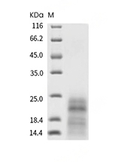Shopping Cart
- Remove All
 Your shopping cart is currently empty
Your shopping cart is currently empty

TACI Protein, Human, Recombinant (His) is expressed in HEK293 mammalian cells with His tag. The predicted molecular weight is 14.8 kDa and the accession number is O14836-2.

| Pack Size | Price | Availability | Quantity |
|---|---|---|---|
| 100 μg | $386 | In Stock | |
| 200 μg | $682 | 7-10 days | |
| 500 μg | $1,440 | 7-10 days |
| Biological Activity | Activity testing is in progress. It is theoretically active, but we cannot guarantee it. If you require protein activity, we recommend choosing the eukaryotic expression version first. |
| Description | TACI Protein, Human, Recombinant (His) is expressed in HEK293 mammalian cells with His tag. The predicted molecular weight is 14.8 kDa and the accession number is O14836-2. |
| Species | Human |
| Expression System | HEK293 Cells |
| Tag | C-His |
| Accession Number | O14836-2 |
| Synonyms | tumor necrosis factor receptor superfamily, member 13B,TNFRSF14B,TACI,RYZN,IGAD2,CVID2,CVID,CD267 |
| Construction | A DNA sequence encoding the human TNFRSF13B isoform 2 (O14836-2) extracellular domain (Ser 2-Thr 120) was expressed, with a polyhistidine tag at the C-terminus and a signal peptide at the N-terminus. Predicted N terminal: Ser 2 |
| Protein Purity | > 90 % as determined by SDS-PAGE  |
| Molecular Weight | 14.8 kDa (predicted); 14-22 kDa (reducing condition, due to glycosylation) |
| Endotoxin | < 1.0 EU/μg of the protein as determined by the LAL method. |
| Formulation | Lyophilized from a solution filtered through a 0.22 μm filter, containing PBS, pH 7.4. Typically, a mixture containing 5% to 8% trehalose, mannitol, and 0.01% Tween 80 is incorporated as a protective agent before lyophilization. |
| Reconstitution | A Certificate of Analysis (CoA) containing reconstitution instructions is included with the products. Please refer to the CoA for detailed information. |
| Stability & Storage | It is recommended to store recombinant proteins at -20°C to -80°C for future use. Lyophilized powders can be stably stored for over 12 months, while liquid products can be stored for 6-12 months at -80°C. For reconstituted protein solutions, the solution can be stored at -20°C to -80°C for at least 3 months. Please avoid multiple freeze-thaw cycles and store products in aliquots. |
| Shipping | In general, Lyophilized powders are shipping with blue ice. |
| Research Background | Tumor necrosis factor receptor superfamily, member 13B (TNFRSF13B) also known as Transmembrane activator and CAML interactor (TACI) and CD267 antigen, is a member of the tumor necrosis factor receptor superfamily. TNFRSF13B is a trimeric cytokine receptor that binds tumor necrosis factors (TNF). The receptor cooperates with an adaptor protein which is important in determining the outcome of the response. Members of the TNF receptor superfamily (TNFRSF) have crucial roles in both innate and adaptive immunity and in cellular apoptosis process. Apoptosis is a cell suicide mechanism that enables metazoans to control cell number in tissues and to eliminate individual cells that threaten the animal's survival. Certain cells have unique sensors, termed death receptors or tumour necrosis factor (TNFR), on their surface. Tumour necrosis factors (TNFR) detect the presence of extracellular death signals and, in response, they rapidly ignite the cell's intrinsic apoptosis machinery. TACI/TNFRSF13B/CD267 induces activation of the transcription factors NFAT, AP1, and NF-kappa-B and plays a crucial role in humoral immunity by interacting with a TNF ligand. |

Copyright © 2015-2025 TargetMol Chemicals Inc. All Rights Reserved.